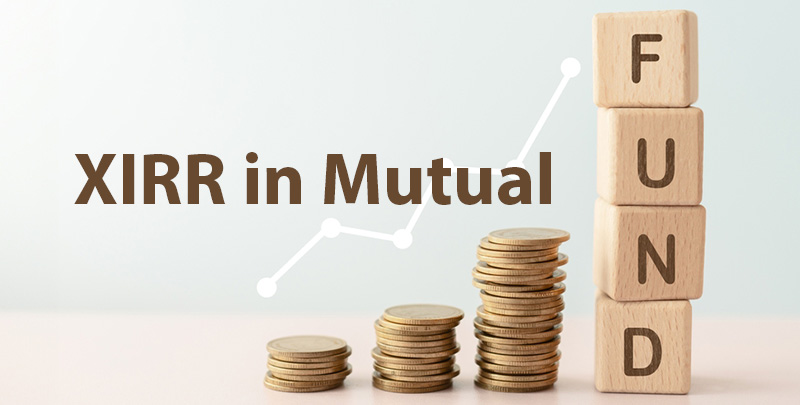Even wondered how to calculate the returns on your SIP in a Mutual Fund. When you invest in mutual funds through multiple transactions at different intervals, traditional return calculations fall short. XIRR is a smart way gauge the performance of your investments which are spread over time.
It's the extended internal rate of return that accounts for the timing and amount of each cash flow, giving you a precise picture of your investment's actual performance, which is especially crucial for SIP investors making regular contributions over time.
What is XIRR?
The meaning of XIRR in mutual fund investments refers to the 'Extended Internal Rate of Return,' - a financial metric that calculates the annualised return on investments involving multiple cash flows occurring at irregular intervals.
Unlike simpler metrics, XIRR considers both the amount and timing of each transaction, whether it's an investment or redemption. This makes it particularly valuable for mutual fund XIRR calculations, where investors make multiple transactions at varying NAVs throughout their investment journey.
Exploring XIRR in mutual funds
- Provides a standardised annual rate of return despite irregular cash flows.
- Account for the time value of money in your investment calculations.
- Offers a more realistic performance measure than absolute returns.
- Helps compare different mutual fund schemes on an equal footing.
- Enables accurate tracking of SIP investments with multiple entry points.
Defining XIRR and its relevance
XIRR in mutual funds functions as a sophisticated financial calculation that determines the internal rate of return for a series of cash flows occurring at irregular intervals. Its relevance stems from the reality that most investors don't make lump-sum investments only.
Rather, they add money periodically, withdraw occasionally, and reinvest dividends. By accounting for these varied transactions and their specific dates, XIRR delivers a precise annualised return figure that reflects your actual investment experience.
The role of XIRR in mutual fund investments
The true power of mutual fund XIRR lies in its ability to create an apples-to-apples comparison between different investment strategies. When evaluating the performance of SIPs versus lump-sum investments or comparing two funds with different investment patterns, XIRR becomes indispensable.
It eliminates distortions caused by varying investment amounts and timings, allowing you to make informed decisions based on standardised performance metrics rather than misleading absolute returns.
How to calculate XIRR in mutual funds
- Record all transaction dates and corresponding amounts (investments as negative values)
- Include the current portfolio value as a positive amount on the current date
- Use Microsoft Excel's XIRR function or online calculators for computation
- Verify that investment dates align with actual transaction dates for accuracy
- Express the result as a percentage representing your annualised return
XIRR formula
The XIRR formula involves an iterative calculation process that can't be solved directly like simpler formulas. Mathematically, it's represented as:
0 = Σ [Pi / (1 + XIRR)^(di/365)]
Where Pi represents each cash flow, and di represents the number of days from the initial transaction date.
While this appears complex, modern spreadsheets and financial calculators have simplified the process through built-in XIRR functions that handle these calculations automatically.
Steps to calculating XIRR
To calculate XIRR in mutual funds, here's what you need to do:
- Begin by creating a spreadsheet with two columns, i.e., dates and corresponding cash flows.
- Enter investment amounts as negative values and redemptions (including current value) as positive values.
- You can use the XIRR function in Excel by selecting your cash flow range and date range.
- The resulting percentage represents your annualised return.
- For regular monitoring, update your current portfolio value periodically to track performance changes over time.
What are the benefits of calculating XIRR in a mutual fund?
Calculating XIRR in mutual funds offers numerous advantages for investors:
- It provides an accurate picture of your actual returns regardless of investment patterns, eliminating the distortions caused by varying investment amounts and timing.
- It enables meaningful comparisons between different funds and investment strategies, helping you identify truly superior performers.
- It facilitates realistic goal tracking by showing whether your investments are growing at the rate required to meet your financial objectives.
- It helps you evaluate fund manager performance more accurately, as it accounts for when money was invested rather than simple point-to-point returns.
What is the difference between XIRR and CAGR?
- Calculation basis: CAGR works only with a single initial investment and final value, while XIRR handles multiple cash flows at irregular intervals.
- Application: CAGR suits lump-sum investments held for a specific period; XIRR excels with SIPs and investments with multiple entry/exit points.
- Time sensitivity: XIRR accounts for exactly when each transaction occurred, while CAGR only considers the beginning and ending dates.
- Complexity: CAGR uses a simpler formula that can be calculated manually; the XIRR formula requires iterative calculations typically performed by software.
Maximizing returns: The importance of XIRR in investment decisions
- Helps identify your best-performing funds based on actual investment patterns.
- Enables data-driven decisions about increasing allocation to outperforming funds.
- Provides clarity on whether to continue or stop underperforming SIPs.
- Assists in rebalancing portfolios based on risk-adjusted returns.
How XIRR influences mutual fund selection
What is XIRR in mutual funds that makes it so crucial for fund selection? It reveals the true performance of your investments, accounting for market timing and investment patterns.
By calculating XIRR across different fund categories, you can identify which fund managers consistently deliver superior risk-adjusted returns regardless of when you invested. This insight helps you avoid the common mistake of selecting funds based solely on advertised returns, which rarely reflect your actual investment experience.
Strategies for improving XIRR in your portfolio
To enhance your portfolio's mutual fund XIRR, consider implementing Systematic Investment Plans (SIPs) during market downturns to benefit from rupee cost averaging. Avoid emotional selling during market volatility, as exiting at low points severely impacts XIRR.
Regularly review and rebalance your portfolio to maintain your target asset allocation. Additionally, consider tax-efficient withdrawal strategies to minimise the impact on overall returns, and leverage top-up investments during market corrections to improve your average purchase price.
Conclusion
Understanding XIRR in mutual funds transforms how you evaluate investment performance and make decisions. Unlike simplistic metrics, XIRR provides a comprehensive picture of your actual returns by accounting for the timing and amount of every transaction.
By mastering this powerful metric, you gain clarity on which investments truly deliver value, enabling more informed decisions about where to allocate your capital. For serious investors, particularly those using SIPs, XIRR isn't just a calculation—it's an essential tool for building long-term wealth.
Also Read: Expense ratio in Mutual Fund: Meaning, components & calculation
FAQs
What makes a good XIRR for mutual funds?
A good XIRR typically exceeds inflation by at least 4-6% for debt funds and 7-10% for equity funds. However, "good" varies based on your investment goals, risk tolerance, and market conditions. Compare your XIRR against appropriate benchmarks rather than arbitrary numbers to evaluate performance meaningfully.
Can XIRR be used for SIP investments?
Yes, XIRR is perfectly suited for SIP investments and provides the most accurate measure of returns for systematic investments. Since SIPs involve multiple transactions at different NAVs, XIRR accounts for both the timing and amount of each investment, giving you the true annualised return on your SIP portfolio.
How often should I calculate XIRR for my investments?
Calculate XIRR quarterly to maintain awareness without overreacting to short-term market fluctuations. However, for long-term investments like retirement funds, semi-annual or annual calculations are sufficient. The key is consistency in your evaluation schedule to track meaningful performance trends over time.
Is XIRR effective for short-term investments?
XIRR remains mathematically accurate for short-term investments but becomes more meaningful over longer periods. For investments held less than a year, XIRR may be disproportionately affected by market volatility or entry/exit timing. Short-term liquid funds and overnight funds are exceptions where short-period XIRR calculations remain relevant.
Disclaimer: This article is for information purpose only. The views expressed in this article are personal and do not necessarily constitute the views of Axis Bank Ltd. and its employees. Axis Bank Ltd. and/or the author shall not be responsible for any direct / indirect loss or liability incurred by the reader for taking any financial decisions based on the contents and information. Please consult your financial advisor before making any financial decision.
Mutual Fund investments are subject to market risk, read all scheme related documents carefully. Axis Bank Ltd is acting as an AMFI registered MF Distributor (ARN code: ARN-0019). Purchase of Mutual Funds by Axis Bank’s customer is purely voluntary and not linked to availment of any other facility from the Bank. T&C apply.








